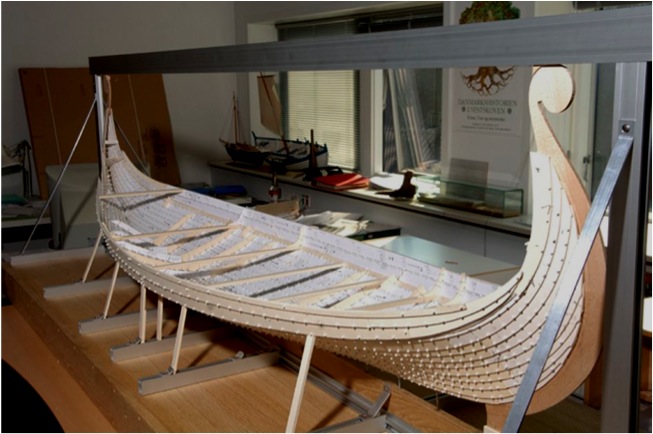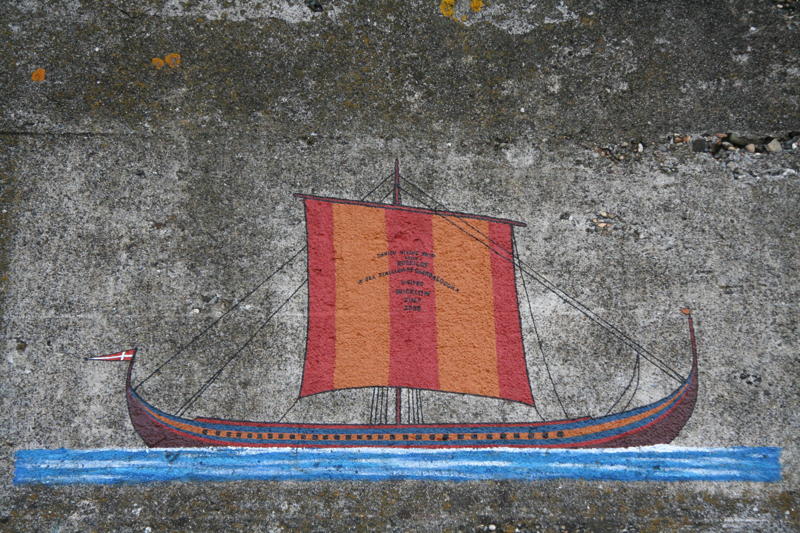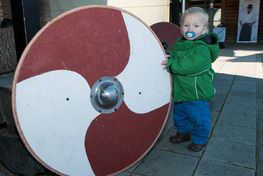Work is now underway on the new reconstruction of the Oseberg ship on the quay in Tønsberg. This is an ambitious project using original materials, tools and construction methods. The goal is to achieve a full-scale sailing reconstruction that can contribute new insights into Viking Age ships, how they were built and how they were used. The ship is being built by professional boat builders and volunteers in cooperation.
The world’s oldest
The Oseberg ship, which was excavated in 1904, contained one of the largest finds of objects from the Viking Age and the ship, which is from 820, is the oldest Viking ship find in the world. The Viking Ship Museum launched the Sea Stallion from Glendalough in 2004. The ship is a reconstruction of the Skuldelev 2, which was originally built in Ireland in 1042. The 262 years between the Oseberg and Skuldelev 2 will provide researchers and boat-builders with a fantastic insight into the Viking ship’s technological development, when the full-scale reconstruction of the Oseberg sails on the sea once again.
In 2006, SNOS (The New Oseberg Ship Foundation) approached the Viking Ship Museum in Roskilde. SNOS was interested in collaborating on the new reconstruction, building and sea trials of a new Oseberg ship. The ship shall be located in Tønsberg, not far from Oseberg, where the original ship was originally found.
The first phase of the project was a new assessment of ship’s hull design. Vibeke Bischoff, the Viking Ship Museum’s ship reconstructor, went to Oslo, where she and Geir Røvik from SNOS reviewed the original ship and all the material from the excavation. “Since the sinking of the “Dronningen”, there have been many hypotheses about what could have been the cause. Was it the design of the hull; were there too few people aboard, too little ballast or too much sail? The only way we could find the answers was by reviewing the original material”, explains Vibeke, who acted as head of the reconstruction work in Oslo. “Before the work commenced, the original ship was scanned inside and out with sophisticated scanning technology and, along with photos and drawings from the excavation in 1910, we obtained very accurate material concerning the original ship.
Errors in reconstruction
The review of the large volume of material revealed several errors in the original interpretation of the ship’s design. “The errors have certainly contributed to the reconstruction having a number of unfortunate handling characteristics” explains Vibeke and continues, “The ship had a larger volume below the waterline and was wider above the waterline compared to what we see in the Viking Ship House at Bygdøy in Oslo.”
The entire reconstruction work has been thoroughly documented in a report from 2007.
Focus on Norway’s Viking Age
In Vestfold in Norway, where the Oseberg ship was found, there is a great deal of historical evidence concerning the life of the Vikings. The Gokstad ship and Norway’s oldest city, Kaupang near Larvik, are other Viking finds. Several sailing reconstructions of the Gokstad ship have been produced, including Gaia, which is located in Sandefjord. The building of a new Oseberg ship will place further focus on Vestfold, as Norway’s centre for the communication of knowledge about the Viking Age. The construction site in the centre of Tønsberg attracts a large number of tourists every day and provides an excellent opportunity for this communication.
A sailing Viking ship
When the full-scale reconstruction is launched according to schedule in October 2011, yet another chapter will be added to our knowledge of the Viking Age vessels. Vibeke Bischoff: “At the Viking Ship Museum here in Roskilde here, we are very interested in learning about how these ships sailed. We already know a great deal, but each reconstruction provides us with new questions and answers. The sea trials with the Oseberg ship will be the culmination of all the hard work that is taking place before the building of the ship. The next questions about the size and design of the rigging, the crew’s handling of the ship and the ship’s sailing quality will hopefully be answered here. Then we will learn something new that we can take further and use in future research on Viking ships.”


![Jigmi Y. Thinley [Translate to english:] Museumsinspektør Anne Sørensen tog imod premierministeren fra Bhutan Mr. Jigmi Y. Thinley og viste ham og hans delegation rundt på Vikingeskibsmuseet. Foto Werner Karrasch](/frontend/Fotoarkiv-andre/09_01.jpg)
